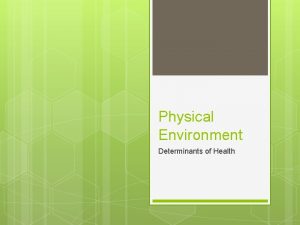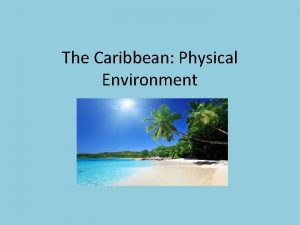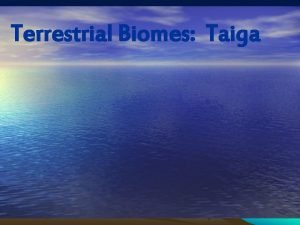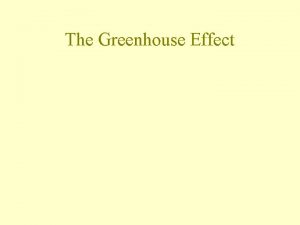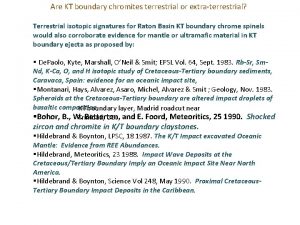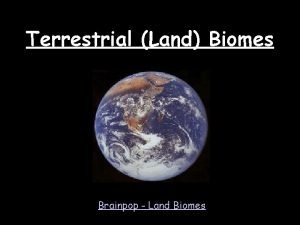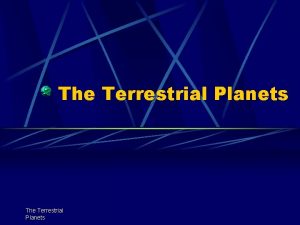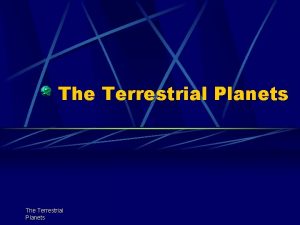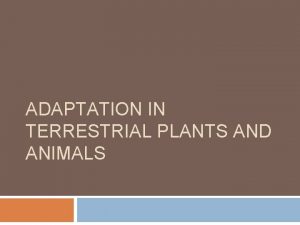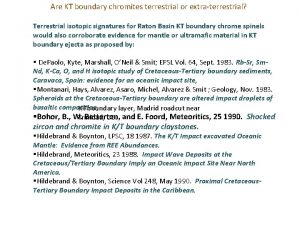The Terrestrial Environment Terrestrial Environment Physical environment of
















- Slides: 16

The Terrestrial Environment

Terrestrial Environment • Physical environment of land dwelling organisms. • ECOSYSTEMS are interactions between: – Physical environment (Soil, air) – Living things • Producers (plants) that make their own food during photosynthesis • Consumers – organisms that eat other organisms (plants and animals) • Decomposers (bacteria/ fungi) - organisms that decay remains of dead organisms.

Feeding Relationships • Food chains- feeding sequences amongst organisms in ecosystems. Producer Primary consumer Secondary consumer tertiary consumer Herbivore carnivores/ omnivores • Food webs are several food chains interlinked

SOILS • Formed from weathering of rocks by environmental factors: – Rain – Wind – Freezing – Thawing • Weathered rocks form small particles called rock waste. • Plant need soil for: – Anchorage – Nutrient minerals – Water – Air

SOIL COMPONENTS • Soil consists of 5 main components: – Mineral particles • Small rock particles – Air • Air spaces between particles with a mixture of gases – Water with nutrient ions • Found in spaces between particles – Humus • Organic matter or dead remains of plants and animals • Coats mineral particles so soil particles clump together. • Provides food for living animals within the soil. – Living organisms • Animals, plants and microorganisms (fungi, bacteria)

Soil Types Gravel Sand Silt Clay Particle size Bigger than 2 mm 0. 02 mm 0. 002 mm Less than 0. 002 mm Water drainage Very Free poor Poor Water retention Very Poor Good (waterlogged) Air spaces large medium small Very small


Discussion • Use the results to compare the soil types. Which soil type was the most abundant and which one was the least abundant? • What type of drainage do you expect this soil to have? Why? • How could the drainage be improved? • List some limitations or sources or error.

SOILS Physical weathering Chemical weathering • Temperature changes • Rock and mineral • Rain water particles dissolved by rain • Root action water

Soil Types • Sandy – Drain easily – Warm up quickly • Clay – Do not drain easily (waterlogged) – Do not warm up quickly • Loam – Mixture of sandy and clay – Drain freely but hold enough water for plants – Best type for gardens

Soil Types • Soils differ because: – It is formed by different rocks – Particle sizes vary • Water drainage and air spaces will vary – Humus content varies • Fertility depends on the amount of humus or organic matter in soil • Humus – Provides mineral ions for plants – Binds soil preventing erosion – Helps soil warm up quickly so seeds grow – Allows free drainage while keeping in some water

Soil Fertility and Crops • Soil must provide enough Minerals, Water, Air • Fertility is how well a soil can grow crops. – Constantly improved by • Adding natural, organic (manure) or artificial, inorganic fertilizers • Using good farming practices – Balance organic and inorganic fertilizer use – Crop rotation – Hedgerows ( mixture of large and small fields) – Liming soils (addition of Calcuim to improve p. H and soil structure)

Soil erosion • Removal of soil particles by wind, water or human activities (agriculture or development) Caused by coastal development… & removal of coastal trees

Caused by land clearing…

SOLUTIONS Build walls & silt traps Maintain vegetation

SOLUTIONS • Use good agricultural techniques – Contouring, benching or terracing – Wind breaks
 Phản ứng thế ankan
Phản ứng thế ankan ưu thế lai là gì
ưu thế lai là gì Thẻ vin
Thẻ vin Môn thể thao bắt đầu bằng chữ f
Môn thể thao bắt đầu bằng chữ f Cái miệng xinh xinh thế chỉ nói điều hay thôi
Cái miệng xinh xinh thế chỉ nói điều hay thôi Hát kết hợp bộ gõ cơ thể
Hát kết hợp bộ gõ cơ thể Từ ngữ thể hiện lòng nhân hậu
Từ ngữ thể hiện lòng nhân hậu Trời xanh đây là của chúng ta thể thơ
Trời xanh đây là của chúng ta thể thơ Tư thế ngồi viết
Tư thế ngồi viết Voi kéo gỗ như thế nào
Voi kéo gỗ như thế nào Thứ tự các dấu thăng giáng ở hóa biểu
Thứ tự các dấu thăng giáng ở hóa biểu Thơ thất ngôn tứ tuyệt đường luật
Thơ thất ngôn tứ tuyệt đường luật Hổ sinh sản vào mùa nào
Hổ sinh sản vào mùa nào đại từ thay thế
đại từ thay thế Thế nào là hệ số cao nhất
Thế nào là hệ số cao nhất Diễn thế sinh thái là
Diễn thế sinh thái là Vẽ hình chiếu vuông góc của vật thể sau
Vẽ hình chiếu vuông góc của vật thể sau



















